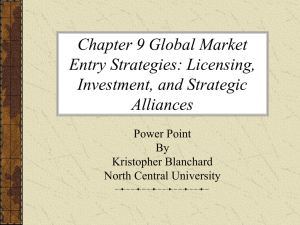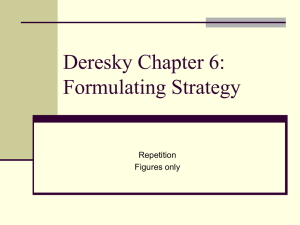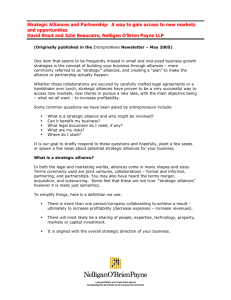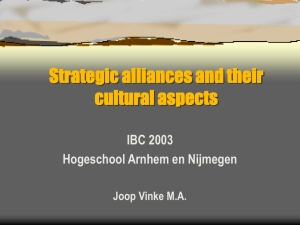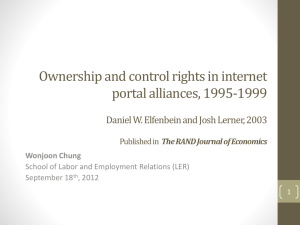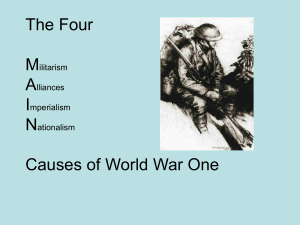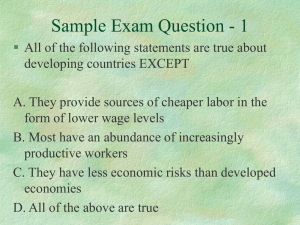JOINT VENTURE MANAGEMENT AND DESIGN
advertisement
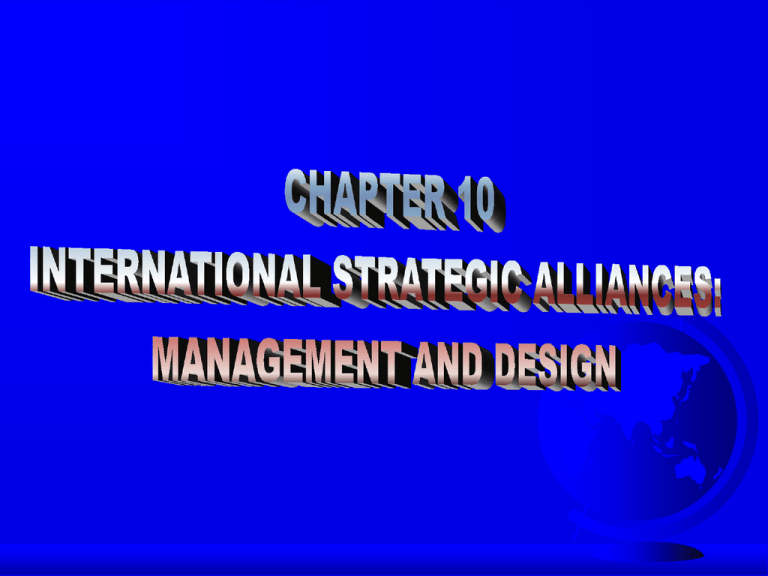
STRATEGIC ALLIANCES ISSUES Stability and risk Failure rate of 30 to 60 percent Even profitable alliances can be torn by conflict SUCCESSFUL ALLIANCES MUST: NOT ONLY MAKE STRATEGIC SENSE BUT ALSO REQUIRE GOOD IMPLEMENTATION (SEE EXHIBIT 10.1 FOR STEPS IN IMPLEMENTATION OF STRATEGIC ALLIANCES) Decide Link in Value Chain Begin Ov er No Select a Potential Partner Acceptable? Yes Choose an Alliance Type Negotiate an Agreement Build the Organization Build Trust and Commitment Assess Performance Terminate or Rev ise Implementation No Meets Strategic Obj ectiv es? Yes Continue or Increase Inv olv ement WHERE TO LINK IN THE VALUE CHAIN? Depends on the objectives that the firm seeks to achieve Exhibit 10.2 gives some examples of common links in the value chain Company A R&D Company B R&D Input Logistics R&D Input Logistics Supply/ Production Operations Operations Operations Production/ Marketing Marketing and Sales Marketing Marketing and Sales Output Logistics Delivery Output Logistics Service Service EX 10.3 VALUE CHAIN LINKS IN U.S. ALLIANCES 60 50 C anada or M exico 40 % 30 W. Europe or Japan 20 Other Prod./M kt. M kt. Oper. 0 R&D 10 Others SELECTING A PARTNER: THE MOST IMPORTANT CHOICE? Seek – Strategic complementarity – Skill complementarity – Compatible management styles ISSUES TO CONSIDER IN CHOOSING A PARTNER The level of mutual dependency The "anchor" partner The "elephant and the ant" complex Operating policy differences Difficulties of cross-cultural communication TYPES OF STRATEGIC ALLIANCES Informal international cooperative alliances Formal international cooperative alliances International joint ventures INFORMAL COOPERATIVE ALLIANCES (ICAs) Nonlegally binding agreements between companies from two or more countries Limited involvement between companies FORMAL COPPERATIVE ALLIANCES Higher degree of involvement than informal ICAs Formal contract Popular in high tech industries because of high costs and risks INTERNATIONAL JOINT VENTURES Separate legal entity owned by two or more parent companies from different countries No need for equal ownership Equity based on cash or other contributions EX 10.5 TYPES OF ALLIANCES: SUMMARY Alliance Type Degree of Involvement Ease of Dissolution Visibility to Competitors Contract Legal Entity Informal ICA Usually limited in scope Easy, at the convenience of either side Often unknown to competitors No None Formal lCA Deeper involvement More difficult Often visible Yes to dissolve to competitors prior to end of contract None IJV Most difficult to dissolve Yes, Deep involvement High visibility Yes NEGOTIATING THE AGREEMENT Joint venture contracts: legal documents that bind partners together The formal agreement is not as important as the ability of managers to get along EXHIBIT 10.6 ISSURES IN ALLIANCE AGREEMENTS For both ICAs and IJVs – Under which country’s law does the agreement operate? – How will profits be divided? – Do you need a prenuptial agreement? Primarily for IJVs – What are the equity contributions of each partner? ORGANIZATION DESIGN IN STRATEGIC ALLIANCES DECISION MAKING CONTROL Majority ownership does not necessarily = control Operational decisions Strategic decisions MANAGEMENT STRUCTURES DOMINANT PARENT One parent controls strategic and operational decision making Dominant parent often has majority ownership Dominant parent treats the IJV as wholly owned subsidiary SHARED MANAGEMENT Both parents contribute approximately the same number of managers to the board of directors, the top management team, and functional area management SPLIT CONTROL Partners usually share strategic decision making Partners split functional decision making INDEPENDENT MANAGEMENT IJV managers act like managers from a separate company IJVs often recruit managers from outside the parent companies ROTATING MANAGEMENT Key positions rotate among partners Popular in developing countries Trains management talent and transfers expertise CHOOSING AN ALLIANCE MANAGEMENT STRUCTURE If one parent has dominant equity position – Dominant management structure more likely Equal ownership – Shared, split, or rotating management structure preferred Similar technologies or knowhow – Shared management structure preferred If different technologies or know-how – Split management structure preferred If the venture has more strategic importance to one partner – Dominant management structure preferred HUMAN RESOURCE MANAGEMENT IN STRATEGIC ALLIANCES The HRM functions of an IJV are more complex because managers (and sometimes workers) come from two or more firms or from two or more cultures HRM ISSUES HRM planning Parent involvement Staffing the alliance management and technical personnel Staffing the alliance workforce Assigning managers strategic or operations tasks HRM ISSUES (CONTINUED) Performance assessment Loyalty Career development Cultural differences Training COMMITMENT AND TRUST: THE SOFT SIDE OF ALLIANCE MANAGEMENT Without trust and commitment the JV will fail entirely or never reach its potential TRUST The confidence that the partner will deliver on their expected contributions to the joint venture “Trust cycles” WHY IS TRUST IMPORTANT? Required for IJV participants to contribute tacit knowledge and quality inputs Weakness of formal contracts can never identify all the issues KEY FACTORS FOR COMMITMENT Pick your partner carefully Know your strategic goals and your partner's Seek win-win situations Go slowly Invest in cross-cultural training Invest in direct communication ASSESSING ALLIANCE PERFORMANCE Match strategic objectives with performance measures EXHIBIT 10.8 SELECTED PERFORMANCE CRITERIA FOR STRATEGIC ALLIANCES Management Processes Organizational Learning Competitive Marketing Financial IF THE ALLIANCE DOES NOT WORK Negotiate an end or improve implementation Know when to quit/invest more Avoid “escalation of commitment” Plan end - “prenuptial agreements” Death not always failure CONCLUSIONS The importance of international strategic alliances Most important decision: picking the right partner No set structure in ownership, decision making control, or management control

